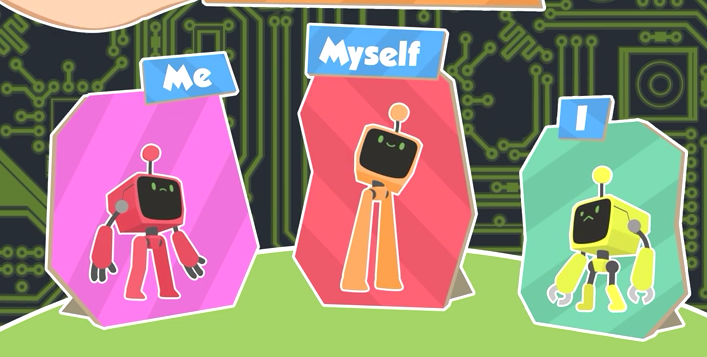Me, myself, and I.
Me,myself 和 I。
You may be tempted to use these words interchangeably because they all refer to the same thing,
你会很想将这些词交换使用,因为它们全都表示一样的东西。
but in fact, each one has a specific role in a sentence.
但事实上,每一个词在句子里都有其特定角色。
"I" is a subject pronoun, "me" is an object pronoun, and "myself" is a reflexive or intensive pronoun.
I是主格代词,Me是宾格代词,而myself则是反身代词或强调代词。
So what does that reveal about where each word belongs?
每个词的角色将如何决定其放置的位置呢?

Let's start with the difference between subject and object.
我们从主格和宾格之间的差别开始吧。
Imagine the subject as the actor in a sentence and the object as the word that is acted upon.
想像一下主格是句子里的行动者,而宾格是接受行动的词。
"I invited her but she invited me."
例如:我(主格I)邀请她(宾格her),但她(主格She)邀请我(宾格me)。
The object can also be the object of a preposition.
宾格也可以是介词的宾格。
"She danced around me, while he shimmied up to me."
例如:她(主格She)绕着我(宾格me)舞蹈,而他(主格he)向着我(宾格me)西迷舞过来。
In some languages, like Latin and Russian, most nouns have different forms that distinguish subjects from objects.
在一些语言中,如拉丁文和俄文,多数的名词都有不同的形式来区别主格和宾格。
However, in English, that's only true of pronouns.
但是在英文里面,只有代词有这样的特性。
But so long as you know how to distinguish subjects from objects, you can figure out what belongs where.
但只要你会区分主格和宾格,你自然就知道什么词该放在什么地方。
And when you encounter a more complicated sentence,
而当你遇到更复杂的句子,
say one that involves multiple subjects or objects, and you're not sure whether to use "I" or "me,"
比如说一个句子里有好几个主格或宾格,你不肯定到底要用 或用me,
just temporarily eliminate the other person, and once again distinguish subject from object.
那就先把其他人拿掉,再尝试区分主格和宾格。
Here's another. You wouldn't say, "Me heard gossip," but sub in "I" and you're good to go.
还有一个例子。你不会说 “Me听到谣言”,但只要把me换成I就好了。











